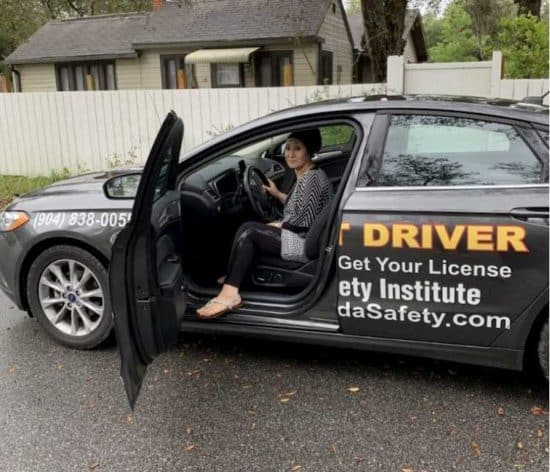Tips for driving in the U.S.
Each state in the U.S. has laws about who can drive and how to stay safe on the road. Learn how to get a driver’s license and learner’s permit. Get tips on safety, buying a car, car insurance, and registering your car.
How to get a driver’s license
To start driving in the US, you must first learn how to drive safely.
Once you have learned how to drive safely, you can apply for a driver’s license which allows you to drive by yourself. The minimum age to drive in the U.S. is between 16 and 18 years old, depending on state laws.
When you apply for a license, you must show documents proving your identity and where you live. In some states, you must also show proof of legal status in the US. Learn more about getting a license if you are undocumented.
To get your driver’s license, you must pass a written test, a vision test, and a road skills test to show that you can drive and park your car safely on the road. Some states offer interpreters during the road skills test. You will need to schedule this test ahead of time online or in person.
States give different types of licenses for driving personal cars, trucks, buses, trailers, motorcycles, and taxis. Most people get a standard driver’s license called Class D – Operator. Driver’s licenses are valid for at least four years depending on which state you live in. If you move to another state, you must exchange your old license for a new license in that state. Visit the Department of Motor Vehicles, known as the DMV, closest to your home for more information on the application requirements and fees.
How to get a learner’s permit
All states require young adults under 18 years old to get a learner’s permit before applying for a driver’s license. A learner’s permit lets you drive a car with a licensed adult over 21 years old. In some states, you must get a learner’s permit if you are a first-time driver of any age.
Many states let people apply for a learner’s permit once they are between 14 and 16 years old. Young adults must pass a vision test and a written test called a knowledge test on a computer about traffic laws to get a learner’s permit. Young adults must hold their learner’s permit for six to nine months before applying for a driver’s license.
Many states also require young adults to sign up for a driver’s education class and practice driving for 6 – 9 months before applying for a driver’s license. Visit your state DMV website for information on how to sign up for a driver’s education program.
Some states also require adults over 18 years old to get a learner’s permit before getting their first driver’s license. In these states, adults have to have their learner’s permit for 30-60 days before getting their driver’s license. Adults can get their driver’s license sooner if they complete a driver’s education class. Visit your local DMV to learn which documents and fees you need to apply for a learner’s permit. Every state has a driver’s manual and practice questions you can study to prepare for the written test. Some states offer translated driver’s manuals and allow you to take the written test in another language.
Driving while undocumented
Right now, 16 states and DC allow undocumented immigrants to apply for learner’s permits and driver’s licenses. If you can not prove legal presence in these states, you may be able to provide other documents instead. Check with the DMV in your state to learn whether you can drive while undocumented.
If you drive without a valid license, you may have to pay a fine or serve time in jail. If you are arrested for driving without a license, you will risk being placed in deportation proceedings.
| You can drive with a valid foreign driver’s license in the USA. Some states might also require an international driving permit (IDP) which must have been issued in the country of your driver’s license. How long you can drive with a foreign driver’s license varies by state. Check with the DMV. |
Important traffic laws
The United States has traffic laws to protect you on the road. You will need to learn the specific laws for your state and always follow these laws.
You must always have a valid driver’s license. It is illegal to drive without a valid driver’s license. If you drive without a license, you can get a ticket and have to pay a fine. In some cases, you can lose your privilege/ability to drive.
You must register your car with your state. All states require drivers to register their car in their state. Keep a copy of proof of registration in your car.
You must have car insurance. Every state requires drivers to have basic insurance to cover costs in case of an accident or injury. Keep a copy of proof of insurance in your vehicle at all times.
You must wear your seatbelt. Everyone in your car must wear a seatbelt whether driving or riding as a passenger. Seatbelts can protect people from injuries in case of an accident. Infants and children must ride in car seats that are strapped securely in your car. Do not hold a child in your lap while driving or riding in a vehicle. Violating these rules will result in fines.
You must follow all traffic rules. Pay attention to traffic lights, stop signs, and speed limits as you drive. You can be ticketed and fined for speeding, making illegal u-turns, and running red lights and stop signs.
You must yield to emergency vehicles, school buses, and pedestrians. You must pull over to let emergency vehicles pass if they have flashing lights and sirens. You must also stop when a school bus is stopped with flashing lights and an extended stop sign. You must yield to or stop for pedestrians crossing the street.
You must stop if you get into a traffic accident. Check to see if anyone is injured and call 911 if they need medical attention. Pull off the road to a safe place and report the crash to the police.
Write down the name, phone number, address, driver’s license number, license plate number, and insurance information of the person you hit or who hit you. If there were people who saw the accident, you should also collect their names and phone numbers. Take photos of any damages. Report the accident to your insurance company immediately.
If you leave the scene of a traffic accident without stopping, you can be charged with a crime and have to pay heavy fines.
You cannot have alcohol or drugs while driving. It is dangerous and illegal to drive under the influence of alcohol and drugs. If you drive drunk or intoxicated, you can be charged with a serious offense called Driving under the influence (DUI) or Driving While Intoxicated (DWI), pay heavy fines, serve probation or jail time, and lose your license. Learn more about drunk driving on the National Highway Traffic Safety Administration (NHTSA) website.
You cannot text or use your phone while driving. It is illegal to text while driving in almost every state in the U.S. Many states also ban handheld or hands-free use of cell phones while driving.
You cannot jaywalk in most states. Jaywalking, or crossing a street without walking to a designated crosswalk, is illegal in most states.
You cannot leave your children or pets unattended in your car. Most states have laws prohibiting leaving children or pets unattended in cars due to safety risks. Leaving children and pets alone in cars can put them in danger of overheating or freezing, dehydration, injuries, kidnapping, and death.
Safe driving tips
Here are some safety tips that can help you stay safe on the road.
Maintain your vehicle. Check your mirrors, lights, tires, brakes, and wiper blades to make sure they are working properly. Make sure to fill your gas tank.
Focus completely on driving. Adjust your mirrors and set up your map and radio before you start driving. Avoid using your phone or eating and drinking while driving. Pull off the road and stop in a safe place in order to use your phone or eat.
Do not drive if you are feeling tired. If you are feeling tired, signal and pull off the road, stop in a safe place and rest.
Always lock your car even when you are inside the car. Keep your valuables out of sight and remember to grab your keys before leaving your car.
Prepare for roadside emergencies. Pull off the road into a shoulder, rest stop or parking lot. Call your insurance for roadside assistance near you.
Prepare for bad weather. Check the weather and avoid driving when the road is icy or it is hailing, flooding, raining, or snowing heavily. If you cannot pull off the road during bad weather, turn on your headlights and drive slowly and keep a far distance from the car in front of you.
Pack a car safety kit in your vehicle. Keep these items in your car to prepare for roadside emergencies and bad weather: first aid kit, flashlight and batteries, spare tire, jack, jumper cables, heavy duty rope, matches and candles, snow shovel, tire chains, blanket, gloves, snacks, and water.
Don’t respond to road rage. Road rage can risk people’s safety on the road. If another driver seems angry or aggressive and is yelling, honking, or driving too close to you, stay calm and patient. Pull over and change lanes, slow down, or exit the highway to let them pass.
Pull over in a safe place if police signal you to stop. Turn off your engine and pull down your window. Stay in your car unless the officer asks you to step out. Place your hands on the wheel or dashboard where the officer can see them at all times. You may be asked to show your driver’s license, vehicle registration, and proof of insurance. You do not have to answer the officer’s questions or consent to a search of your car if you do not want to. Learn more about what to do when stopped by the police.
Buying a car
Buying a car requires a lot of research and planning. If you are buying a car for the first time, it can be very helpful to have a friend or mentor help you figure out how to buy a car.
You can apply for a loan from the bank or credit union to buy a car, but you will have to pay interest on it every month. You can also choose to buy a car with cash.
It is generally more affordable to buy a used car than a new car. You can buy a used car from the owner or from a car dealer. You can negotiate the price.
You should verify that the car’s title is clear and clean and that no one else owns the car. You can check the status of the car’s title through a provider approved by the National Motor Vehicle Title Registration System.
You should get the car title notarized (officially signed) and make sure you get a receipt from the owner of the car.
It’s important to have a mechanic look at the car if you are buying it used. You will also want to test drive the car and make sure it is working before you decide to buy it.
Signing up for car insurance
48 states have laws that require drivers to have car insurance to cover costs of damages and injuries in an accident.
Insurance requirements are different for each state, but most insurances require drivers to at least have liability coverage that covers vehicle damage and physical injuries to the other driver if you are found to be at fault. You can also choose to get comprehensive coverage to cover the cost of damages to your car.
It’s important to keep proof of insurance in your car to show in case you get into an accident. If you are driving a friend’s car, make sure their car is insured.
Visit the DMV website for your state to learn about the specific car insurance requirements for your state.
Registering your car
States require you to title and register your car with the DMV or transportation agency before you can drive your car. When you register your car, you will get a registration card, license plate, and a sticker for your license plate.
If you do not register your car or allow your registration to expire, your car can be towed and you can be fined. It’s important to keep proof of insurance in your car to show in case you are involved in an accident.
Some states also legally require you to pass a safety inspection every year. If you do not show proof of safety inspection in these states, you can be ticketed and fined.
Visit the DMV website in your state to learn more about the documents and fees you need to register your car.
All this information is intended to help you better understand driving in the United States. None of this information should be taken as legal advice. Contact the DMV in your state with any questions and concerns.
The information on this page comes from Department of Motor Vehicles and other trusted sources. We aim to offer easy to understand information that is updated regularly. This information is not legal advice.




